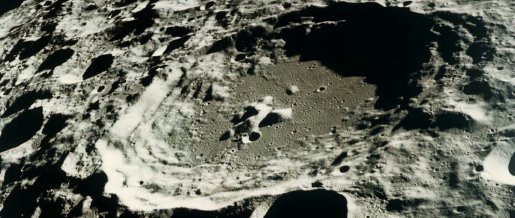 |
|||
|
Apollo 11 view of Crater 308.
|
|||
| THE CRATERS OF THE MOON | |||
| Before Apollo there was still a lot of debate as to how many (if any) of the craters were made by volcanoes. The features which distinguish craters, such as the ejecta, the shape and size of the crater, the location of secondary craters were all carefully considered. The study of close up pictures shows that virtually all the craters on the Moon have been formed by meteorites and very few by volcanic activity. | |||
| Lunar craters have much in common with craters elsewhere in the Solar System - they have rims, central peaks, smooth floors and terraced walls. They also follow similar trends. Craters on the Moon, like craters anywhere else, begin as crisp, fresh looking features with sharp rims, but with time are degraded by micrometeorites hitting the surface, wearing it down. | |||
| Shapes | |||
| Larger craters, those in excess of 21 kilometres, are more complex than smaller craters. Simple craters on the Moon are generally under 16 kilometres across and generally have smooth walls. Craters under 7 kilometres across are the most basic and are nearly all bowl shaped. The relationship between size and complexity is not always straightforward because the transition from simple to elaborate occurs at a different size depending on whether the crater has formed in the mare or the highlands. Mare craters show complex features at smaller diametres. | |||
 Lunar Orbiter view of Tycho crater, showing the classic shape of larger craters. |
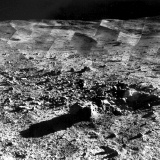 Tycho crater, as seen from the ground by the Surveyor lander. |
||
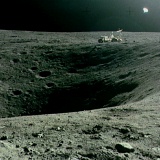 Apollo 16's Lunar Roving Vehicle parked at the side of the bowl-shaped, 40 metres wide, Plum crater. |
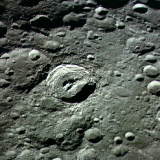 Apollo 15 acquired this image of King crater, surrounded by smaller bowl-shaped craters. |
||
| Ejecta | |||
| Lunar craters, because of the low gravity are able to eject material further than the larger planets. This means that the ejecta apron around the rim is larger than for most bodies. It also means that grooves, pits and secondary craters are distributed over a wider area. Secondary craters associated with the Orientale Basin impact are found 2000 kilometres away. | |||
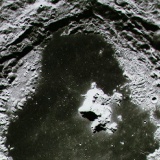 Tsiolkovsky crater and its central mountains, photographed by the crew of Apollo 15. |
 The bright ejecta of Tsiolkovsky crater, Apollo 15 photograph. |
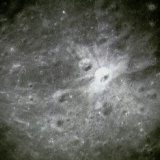 The bright ejecta from this small crater served as a navigational aid for Apollo 16. |
|
| Most of the ejecta is radial, it moves out from the crater centre, equally in all directions. However, some of the crater chains made by flying debris are not aligned with the centre of the main crater. In such cases it appears that the debris has collided with other material thrown outwards at the same time, knocking it off-course. | |||
| Ray craters | |||
| Ray craters on the Moon, as the name suggests, have bright rays or filaments. These extend from the crater rim, across the surrounding plains and show up well against the dark maria. They are produced by the excavation of old lighter coloured rocks which are thrown outward when the crater is made. The most famous ray crater is Copernicus, the namesake crater for the Copernican period when these craters formed. The materials themselves are old but they are deposited back on top of the surface recently. | |||
 Oblique view of Copernicus from Lunar Orbiter. |
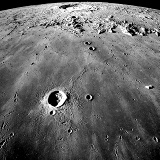 The bright rays from Copernicus can be seen crossing the floor of Mare Imbrium in the foreground. |
||
|
|
|||